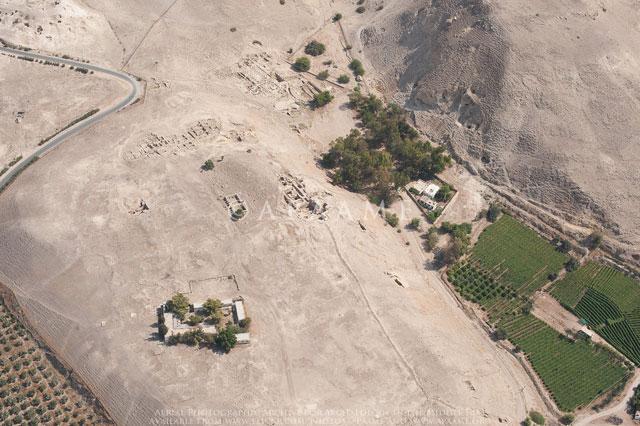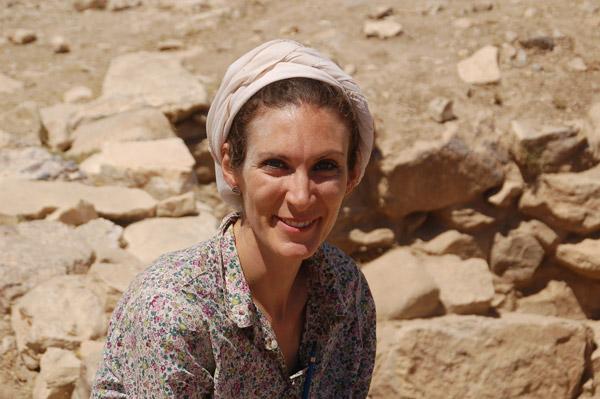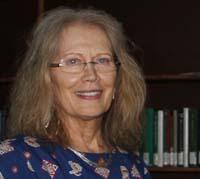You are here
Italian scholar researches crisis, reformation of Near East’s early urban societies
By Saeb Rawashdeh - Apr 12,2018 - Last updated at Apr 12,2018

The arial view of the ancient site of Pella, some 130km northwest of Amman (Photo courtesy of APAAME)
AMMAN — For Italian archaeologist Marta D’Andrea from Sapienza University of Rome, the passage from the Early Bronze Age to the Middle Bronze Age in the Levant is one of the most intriguing research topics in Near Eastern archaeology, as it is intimately related to the understanding of processes of formation, crisis and regeneration of early urban societies in the Near East through the 3rd and 2nd millennia BC.
The trajectories of the northern and southern Levant were similar during the earlier stages of the Early Bronze Age (first half of the 3rd millennium BC), but from the late Early Bronze Age (last centuries of the 3rd millennium BC), the northern Levant saw enduring urbanism while the southern Levant witnessed de-urbanisation, she said.
“However, starting from the early 2nd millennium BC, the trajectories of the northern and southern Levant converged once again, and the Middle Bronze Age was marked by a growing socio-cultural homogeneity between the two parts compared to the Early Bronze Age,” D’Andrea noted.
Important socio-cultural changes from one period to the next included the appearance of new material culture traits — new vessel and weapon types, different urban layout of cities with new fortification systems and architectural templates — and the emergence of the Amorites — a population from the Syrian steppe, the expert explained.
She said that scholars also identified elements of cultural continuity between the Early and the Middle Bronze Age in terms of subsistence strategies, settlement patterns, material culture and technology, which "may suggest that changes did not take place all of a sudden, but emerged from long-term trends".
The understanding of the socio-cultural dynamics lying behind these changes is still obscured by the lack of direct written sources, D’Andrea stressed.
“In the past, the beginning of the second urbanisation in the southern Levant has been traditionally established at ca. 2,000 BC,” she noted, adding that scholars recently proposed 1,950/1,920 BC for the beginning of the Middle Bronze Age in the region based on radiocarbon dates and revised synchronisms between the southern Levant and Egypt.
Temples showing Syrian influence are documented in the southern Levant — such as those at Pella and Tell Al Hayyat, in Jordan — but it is from approximately the early 19th century BC that true urbanism began and fortified cities and towns with palaces and temples were established across the region, D’Andrea underlined.
“Compared to the first urbanisation of the southern Levant in the Early Bronze Age, which was characterised by instability, resulting in a progressive decline, the second urbanisation in the Middle Bronze Age was established permanently in this area,” she continued, attributing this success to its well-rooted inclusion into a wide network of inter-regional connections.
Urbanism vs ruralism
Since the 1980s, scholars have emphasised the dynamic relationship between urbanism and ruralism in the Levant during the Bronze Age, according to the archaeologist.
“Archaeologists have traditionally identified the existence of a lively rural background in the Bronze Age southern Levant as the strong point of the region's socio-economic organisation within the various configurations it achieved through different periods [urban or non-urban], as it permitted flexibility of socio-economic structures and resilience in times of crisis,” D’Andrea highlighted.
The existence of a developed network of villages during the non-urban last phase of the Early Bronze Age was likely one of the driving forces of recovery from the crisis of the first urbanisation, continuing in the earliest phase of the Middle Bronze Age, she underlined.
Scholars also demonstrated that, rather than the backwater of the urbanised space, “the rural countryside was part and parcel not only of the socio-economic organisation, but also of a connected ritual landscape, with temples located not only at major sites like Pella, but also at smaller rural villages like Tell Al Hayyat," she explained.
‘Syrian connection’
The “Syrian connection” is the way scholars traditionally defined elements of the material culture of the southern Levant revealing contacts with Syria during the last phase of the Early Bronze Age (Early Bronze IV or Intermediate Bronze Age), such as the spreading of goblets and cups inspired by northern prototypes, she said.
In the past, such archaeological evidence was taken as a proof of migrations or invasion of Amorites, of movements of pastoralists and refugees escaping from imperialistic politics of the kings of Akkad from Mesopotamia beginning in the mid-24th century BC or of aridification in the Syrian Jazirah around 2,200 BC, D’Andrea claimed.
“To investigate the mechanisms lying behind these phenomena may reveal how various components might have gradually blended into one socio-cultural complex,” she concluded.
Related Articles
AMMAN — A “fascination” with the practice of archaeology was one of the driving motives for Marta D’Andrea, an Italian archaeologist from Sa
AMMAN — For decades, many scholars have attempted to connect the Bronze Age with urbanism in the Levant and some of the archaeologists and h
AMMAN — Bayesian modelling, a method of statistical analysis, applied to Radiocarbon dating, has changed perceptions of the Early Bronze Age














